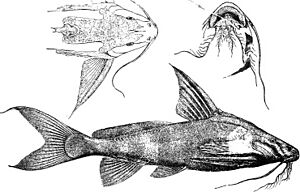Synodontis acanthomias facts for kids
Quick facts for kids Synodontis acanthomias |
|
|---|---|
 |
|
| Conservation status | |
| Scientific classification |
The Synodontis acanthomias is a unique type of upside-down catfish. It lives in the Congo Basin in countries like Cameroon, the Central African Republic, the Democratic Republic of the Congo, and the Republic of the Congo. This fish was first found by George Albert Boulenger in 1899. The name "acanthomias" means "very spiny." This is because the fish has special spines on its body.
Contents
Meet the Spiny Catfish!
This amazing fish is known for its interesting features. It's often called an "upside-down catfish" because some fish in its family swim that way. The first Synodontis acanthomias ever studied is now kept safe in a museum in London. Another fish, called Synodontis pfefferi, was later found to be the same species.
What Does It Look Like?
The Synodontis acanthomias has a grey-brown body with black spots. One special part of this fish is its humeral process. This is a bony spike that sticks out from its head. You can see it past its gill opening. In older fish, this spike has spines, making it look a bit rough.
Fins and Features
The first ray of its dorsal fin (the fin on its back) is hard and has a saw-like edge. Its pectoral fins (on its sides) are also hard and serrated. The fish has three pairs of barbels, which are like whiskers around its mouth. Two of these pairs are branched, like tiny tree branches. Its tail fin is deeply forked, with the top part being longer.
Its Special Teeth
The Synodontis acanthomias has two kinds of teeth. In its upper jaw, the teeth are short and shaped like cones. In its lower jaw, the teeth are S-shaped and can move. This helps the fish eat its food.
Where Does It Live?
In the wild, these catfish can grow quite large. They can reach up to 59 centimeters (about 23 inches) long. They prefer to live in water that is warm, usually between 22 and 24 degrees Celsius (72-75 degrees Fahrenheit). The water's pH level, which tells how acidic or basic it is, should be between 6.5 and 8.0.
Why Is It Important?
The Synodontis acanthomias is important to people in the areas where it lives. It is caught and eaten by humans. This means it has some value for local communities.


